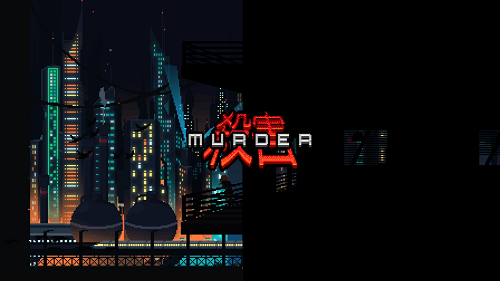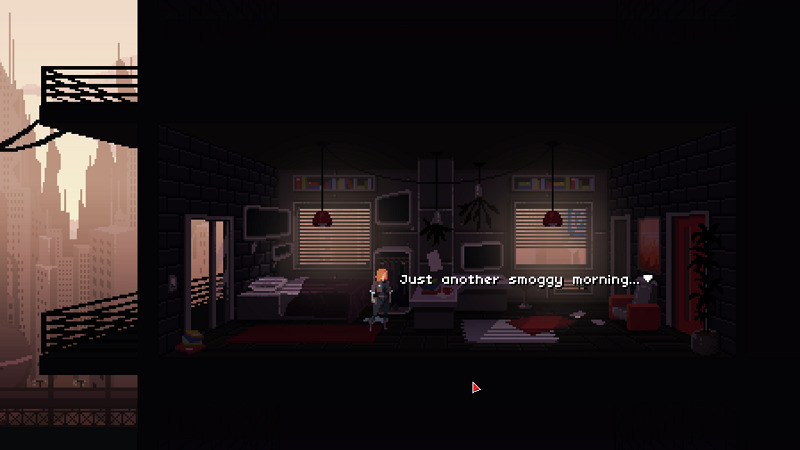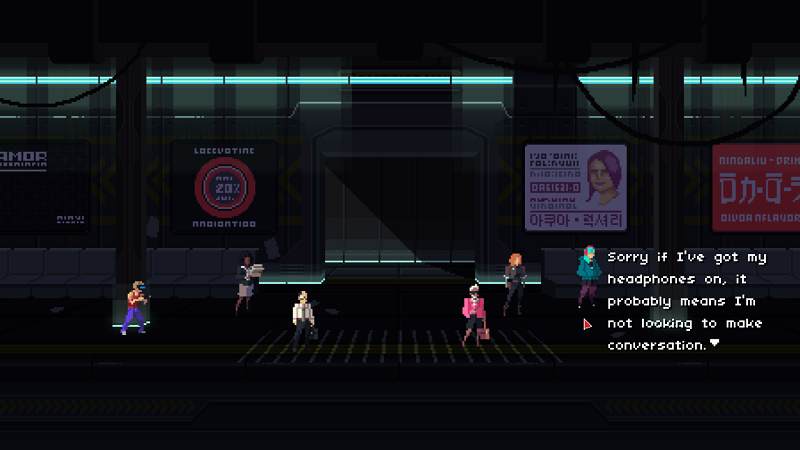Murder
 The title screen. The title screen. |
||
| Developer: | Peter Moorhead | |
| Released: | 2015.10.21 | |
| Genre: | SciFi / Mystery | |
| Graphics: | Pixel art / 2D | |
| Perspective: | Third person | |
| Gameplay: | Point-and-Click |
Science Fiction. Cyberpunk. Pixel arts. Point-and-Click! Japan!!! Is it even theoretically possible to go wrong with that combination? No, of course not, everybody knows that much. Confusingly simply named game Murder serves all that in the form of an experimental adventure game.
From the very first moment it is obvious that much thought and effort has been put into the game. The game begins with an optional tutorial, which like the rest of the game is fully voice-acted. The game mechanics are shown so clearly that even a person with no previous adventure experience will learn it in seconds. It helps that the game is simplified almost to the bare minimum, there are only two kinds of hotspots in the game, those that must be clicked to advance the game, and those which are optional but can provide some additional information to the player.
 The game has some nice graphics.
The game has some nice graphics.
This is also where things start moving into a direction which will certainly divide players into different camps, either liking or disliking what happens. As already indicated, the game is experimental. It plays like a kinetic visual novel, where the player can choose when to advance the story, but not how. There are no puzzles, no inventory, no choices to make, and other than stopping playing, no way to lose in the game. That certainly goes against the traditional definition of an adventure game, with some people making a clear distinction between adventure games, and games like this, which are labelled as visual novels, interactive fiction, multimedia movies, or something else but certainly not adventures.
Because the game is very short, and there is no way to experience a premature game over, there is no save/load options in the game. In what can be described as the most controversial thing in the game, there is a fake ending of sorts, which is really unexpected, but occurs only if the player somehow manages to trigger it during gameplay. When the real ending happens, players are going to wonder if that really is the end or not, and also be confused about the story that was just told, or left untold. Yes, the game leaves more questions unanswered than it even tries to answer, and the story arc will be completed by each player individually in their own thoughts.
What is undeniably true for everyone is that the protagonist is Lieutenant Motomeru Minori of the Tokyo Metropolitan Police, and like the title suggests, a murder happens that she will investigate. And because the game is science fiction there are talking robots (more than there are in Japan nowadays) and huge skyscrapers in the background (taller than there are in Japan nowadays).
 The protagonist waking up.
The protagonist waking up.
Unfortunately it seems that the developers have next to no knowledge about Japanese culture. The characters being voiced in American English can be understood, but the harsh explicit language certainly doesn't match Japanese environment, and it is unbelievable that Japanese language would go from honorifics to profanities in the near future. It is also puzzling that there is an advertisement board on the train station with hangeul writing - while seeing hangeul in Japan isn't completely unrealistic, it certainly is very rare, and unlikely to be seen in advertisements for masses.
Otherwise the game can create a very nice atmosphere. The pixel arts are like a poetic candy, something that hints a mysterious story and leaving a good taste. While the pixels aren't the most handsome ever seen in adventure games, they do a perfect job that they were intended to do here. Too bad there are only few locations in the game, and they are all visited at least twice, so there's not much quantity to speak of, but quality makes up for that.
 Friendly people at the train station.
Friendly people at the train station.
Audio in the game could be better. In an ideal situation the characters would be voiced in genuine nihongo, but the English voiceovers will have to do. They are not bad, but don't stand out either. The soundscape is OK, but there really isn't a worse way to spoil the mood of futuristic Japan than having an English explicit rap song playing after the game is finished. While the game is experimental, the traditional concept of immersion should be worth something. There are some nice little things here and there, one worth mentioning is how a dying robot is saying out lines made famous by HAL when losing his mind.
It can be concluded that the experiment in this experimental game isn't entirely successful. While there is so much to like, the obvious problems make the overall experience kind of neutral. Science fiction adventure game set in future Japan is a brilliant concept no matter how one looks at it, but the degraded Japan experience, the lack of actual gameplay, and controversial design choices mean that the full potential of the concept is never really explored. At any rate, most adventurers will be happier having played Murder than not having experienced it. What one gets from the game is reflective of one's horizon of expectation.
